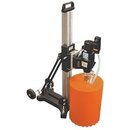cmeb76
Registered
Hello,
Inland diver with customers wanting our team to core drill an 8" diameter hole horizontaly through 20 feet of solid concrete... no head differential. In all our work we have never core drilled underwater. I have cored hundreds of holes in foundations/floors/walls, but always in the dry. I would be thankfull for any info anyone might have on drilling techniques, drill/bit brands, tips/tricks, rental companies that would have the right equipment. We will be drilling at a depth of 30-40', in crystal clear fresh water, but close to freezing in the midwest this winter.
Thanks...
Inland diver with customers wanting our team to core drill an 8" diameter hole horizontaly through 20 feet of solid concrete... no head differential. In all our work we have never core drilled underwater. I have cored hundreds of holes in foundations/floors/walls, but always in the dry. I would be thankfull for any info anyone might have on drilling techniques, drill/bit brands, tips/tricks, rental companies that would have the right equipment. We will be drilling at a depth of 30-40', in crystal clear fresh water, but close to freezing in the midwest this winter.
Thanks...






